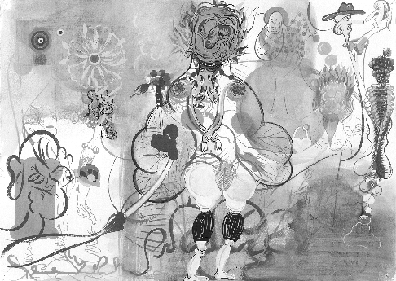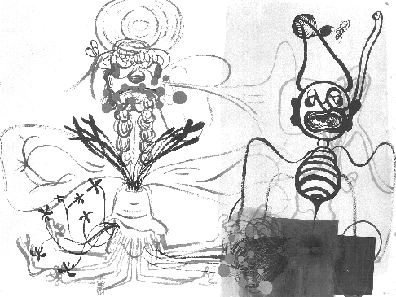Imagine a use of the word writing which might be thinking or
looking.
— Richard Foreman
Among the most interesting and complex versions of this ...
is what might be called the relationship of subversion, in
which language or imagery looks into its own heart and finds
lurking there its opposite...
— WJT Mitchell, Picture Theory

Amy Sillman
Flowerface, 1994.
Gouache on paper.
|
I began writing this statement by thinking about the
language of casual speech rather than that of text, and my
paintings as a concrete form of raconteurism or literal
figures of speech. It struck me that speaking and painting
are both daily acts of improvisation that I perform; they
are both intuitive and deeply reasoned processes that I use
to summon and transform the anarchic, fragmented, repressed,
and marginal. I make an optical poem out of this stuff, the
visual and the verbal refract and extend each other. In
practice, none of the models of polarity between body and
mind, between thinking and doing, between reason and the
irrational make sense to me. I'm playing in the street, at
the intersection between word and image, form and content,
and I look forward to their collision. In fact, recently
more than ever before, I've left words intact in the
paintings exactly as they float through my mind while I'm
working, acting like catalysts for the visual and vice
versa.
|

Amy Sillman
Measles, 1994.
Gouache on paper.
|
Every day I welcome the raw, the goofy, the urgent, the
eccentric, the disrupting, the associative and dissociative,
the distracted, the embarrassing, the transient, the
interesting, and the fearsome into my life, and language is
the welcome mat, the first translation device from the body
of sensate cues I intuit. Painting is a physical thinking
process to continue an interior dialogue, a way to engage in
a kind of internal discourse, or sub-language—mumbling,
rambling, stream of thought, murmuring, thinking out loud,
naming, uttering, a voice in your head. So language is not
just a cognitive device, a ground of critique, a pedagogical
mechanism, a negotiable social structure.
Here's the big difference, for me: while language is a
chronological system going only forward in time, like the
voice-over to your home movie, painting allows for a
revision of time itself through editing, erasure,
compression, simultaneity. In painting you can wipe out,
cover up, remake your body, re-envision your dream, imagine
and then protect yourself—in fact, painting is a
protective, tender gesture in a way that language as I
practice it is not—j'accuse! (I always hated girls who
wouldn't say anything.) Language is also a way to
critique, hate, refuse. Language is a weapon for me to use
as much as to be used by. In this way, I've always trusted
and liked language—I find it reassuring. Sometimes I feel
like an out-of-control, monstrous satellite with only a
little nose-cone of inner language to guide me. How do I
know that I'm not monstrous? Because you can tell me
I'm not. I understand its function to suppress and control,
but language can be familiar, intimate and available, the
one trustworthy thing you have, sometimes the only sibling
you've got. I say this as an only child.
Amy Sillman is a painter who lives in Brooklyn. She is
currently on the faculty of Bard College.
|

